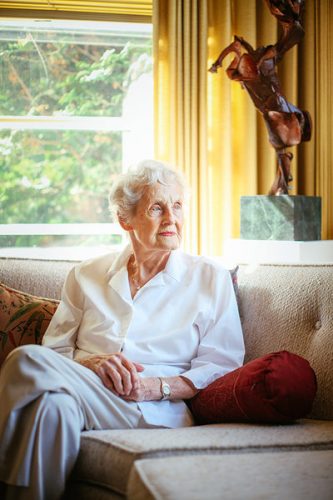
On a dark wintry day in 1942, Hope Pressman crossed Prince Lucien Campbell Memorial Courtyard in the rain toward a lone light shining from the otherwise shadowy UO art museum. The museum, which later became the Jordan Schnitzer Museum of Art, was only open to serious researchers for one hour a week due to a lack of funds. But as a senior studying Chinese history, Pressman needed a book. She made her way to that lone light hanging above the desk of Gertrude Bass Warner, whose library of Asian history and art was housed in the museum. Pressman found the book, quickly scribbled some notes and left.
“It was so intriguing. I was just thrilled,” Pressman remembers. That was the day that began Pressman’s lifelong love and advocacy for the arts.
Many of the cultural institutions in Eugene and Oregon are here, in part, because of Pressman. She is a tireless crusader for the arts, squeezing out support and money even when there appeared to be none. Her accomplishments are too many to list, but here are some of the greatest hits: Pressman was part of a team that got an $18.5 million measure passed to build the Hult Center in 1978; she was the third president of Friends of the Museum, a fundraising organization for the UO art museum; she helped start the Arts in Oregon Association, which secured state grant money from the National Endowment for the Arts. Her numerous awards include Eugene’s First Citizen Award (1987) and the Governor’s Award for the Arts (1988). Pressman also helped organize one of the most prestigious art events Eugene, and perhaps even the world, has ever seen: The Oregon International Sculpture Symposium of 1974.
“When I had finished college and was raising young ones along with a bunch of other young mothers, we wanted to make Eugene an even better place for our kids, culturally, than we felt it was,” Pressman tells me in her living room, which is sprinkled with David McCosh paintings and the works of internationally renowned sculptor Dimitri Hadzi. Pressman moved to Eugene from Idaho for school in 1937. In 1946, she, her husband and their fathers built the house where we sit, overlooking the Laurelwood Golf Course.
“We had the Civic Music Association and the McArthur Court,” she says of the performance venues in town at the time. “Along with the Very Little Theatre, which I recall was out on West 11th in a little house that they converted.” The only places to see the visual arts were the UO art museum and Maude Kerns.
Pressman says the arts scene in Eugene is better now. “We have a plethora of arts organizations here,” she says. “They’re all struggling, of course, but every one of them has a passionate following that will provide support no matter what.”
For burgeoning arts advocates, Pressman has some time-tested advice: “Number one, get a group of people together. Organize … Then you have to have a vision.”
At 93, Pressman has one more vision she wants realized: for “Oracle” — the monumental basalt Stonehenge-esque work Hadzi made for the sculpture symposium in 1974 — to be on public view in Eugene once more. “Oracle” had been on display on top of the Lane County Public Service Building until 2003 when the roof began leaking; now it sits in storage. Pressman has been in talks with the city, the county and the university to bring it into the light ever since. The university has shown some interest in putting it near Frohnmayer Bridge, but the decision is pending.
The sculpture is not only a great work of art, Pressman says, but representative of a six-week period of time when the people of Eugene came together to make an international art event happen. “The whole community was just really wonderful,” she says.